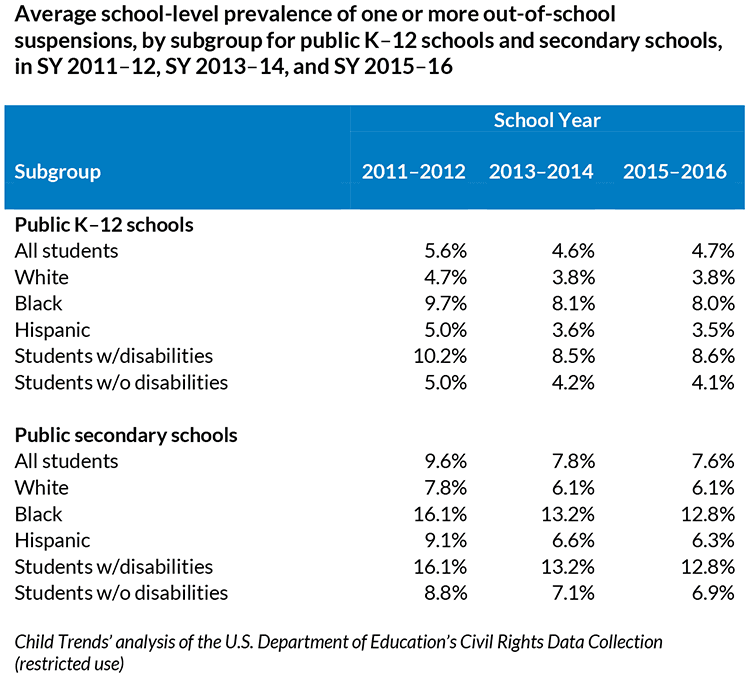Schools report fewer out-of-school suspensions, but gaps by race and disability persist
This blog post reflects data and analysis of school discipline disparities that were current as of school year 2015-2016. For the most recent analysis, with school year 2017-2018 data, see our updated brief published in August 2021.
NPR used analysis featured in this blog as part of a story on school discipline and the Civil Rights Data Collection.
Schools are reporting incremental progress in reducing discipline disparities and reliance on out-of-school suspension, according to new Child Trends analyses, but large gaps by race and disability remain. As state lawmakers work to reform school discipline, the Federal School Safety Commission’s recommendation to repeal federal guidance designed to highlight and help schools address the problem of discipline disparities could instead risk undermining states’ efforts to address the problem.
Shortly after the March 2018 establishment of the Commission, Child Trends recommended continued federal leadership to help schools improve school discipline practice, given research showing the detrimental impact of suspension on our nation’s students. New Child Trends analyses of data from the federal Civil Rights Data Collection (CRDC) illustrate the need for more effective discipline practices, with an explicit focus on reducing disparities in disciplinary exclusion. From school year (SY) 2011–12 to SY2015–16, rates of out-of-school suspension declined and the percentage of schools with significant disparities was reduced. Despite these reductions, suspension rates continue to be high and substantial subgroup disparities persist.
Our analysis found signs of positive trends: In SY2011–2012, schools suspended 5.6 percent of their students, but suspended only 4.7 percent four years later. This trend holds across student subgroups, including white, black, and Hispanic students, as well as students with and without disabilities. Hispanic students experienced the largest decrease—a 30 percent drop—in out-of-school suspension.
While schools are reporting fewer out-of-school suspensions, some discipline disparities remain. On average, schools suspended black students at double the rate of white or Hispanic students, and suspended students with disabilities at more than double the rate of students without. The table below details these breakdowns by year and by subgroup.

Child Trends also examined relative rates of suspension within schools that serve multiple racial and ethnic subgroups (i.e., at least one white and one black or Hispanic student). We used statistical testing to identify schools in which there were meaningful disparities (i.e., a 95 percent likelihood the disparity is real and not by chance) in rates of out-of-school suspension. We found that more than one-third of secondary schools that serve both white and black students (35 percent) had significant disparities in rates of out-of-school suspension between white and black students in SY 2015–16. Nearly half (47 percent) of secondary schools serving youth with and without disabilities had disparities between these groups. Although the percentage of schools with race and disability disparities has declined since SY 2011–12 (by 3.1 percentage points and 1.2 percentage points, respectively), this still represents a significant percentage of schools in the country.
These figures likely understate the scale of the disparities. While we use CRDC data to estimate disparity within a single school year, disparities within a student cohort may accumulate over the course of their K–12 education.
Research suggests a range of systemic, interwoven sources of discipline disparity, including (but not limited to) differences in subgroup discipline both within and between schools; implicit biases held by school staff; and discipline policies with minor, often subjectively defined, offenses (e.g., insubordination and willful defiance). To close disability-related disparities, schools must partner with parents to select appropriate behavioral supports for individualized educational programs. These are complex challenges that merit continued analysis and leadership to ensure that discipline practices are fair and equitable.
Education leaders from across the country—including state superintendents and state governments—have voiced their commitment to addressing school discipline disparities. Given the states’ chosen direction, federal administrators should preserve tools and resources that support the goal of fair and equitable school discipline, or risk undermining the work of state officials as they engage school communities.
© Copyright 2024 ChildTrendsPrivacy Statement
Newsletter SignupLinkedInThreadsYouTube